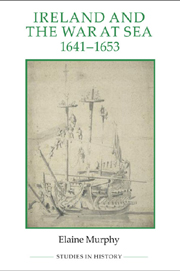Book contents
- Frontmatter
- Contents
- List of figures, maps and tables
- Acknowledgements
- Abbreviations
- Glossary
- Map 1 Ireland, 1641–9: principal ports and locations
- Map 2 The British Isles, 1641–9: principal ports and locations
- Map 3 The British Isles and Europe, 1641–9: principal ports and locations
- Introduction
- PART I The War at Sea, 1651–1653
- Part II Navies and the Conduct of the War at Sea
- 5 A job done well enough? The parliamentary naval effort in Ireland, 1641–1653
- 6 For the defence of the coasts of this realm: the confederate naval effort, 1641–1653
- 7 Fighting the war at sea in Ireland, 1641–1653
- Conclusion
- Appendices
- Bibliography
- General index
- Index of ships
6 - For the defence of the coasts of this realm: the confederate naval effort, 1641–1653
from Part II - Navies and the Conduct of the War at Sea
Published online by Cambridge University Press: 05 April 2013
- Frontmatter
- Contents
- List of figures, maps and tables
- Acknowledgements
- Abbreviations
- Glossary
- Map 1 Ireland, 1641–9: principal ports and locations
- Map 2 The British Isles, 1641–9: principal ports and locations
- Map 3 The British Isles and Europe, 1641–9: principal ports and locations
- Introduction
- PART I The War at Sea, 1651–1653
- Part II Navies and the Conduct of the War at Sea
- 5 A job done well enough? The parliamentary naval effort in Ireland, 1641–1653
- 6 For the defence of the coasts of this realm: the confederate naval effort, 1641–1653
- 7 Fighting the war at sea in Ireland, 1641–1653
- Conclusion
- Appendices
- Bibliography
- General index
- Index of ships
Summary
Prior to the outbreak of war with the Dutch in 1652 the principal maritime threat to parliament came from ports in Ireland. Confederate, and later royalist, privateers put to sea ‘for the defence of the coasts of this realm’ to seize enemy shipping. Any assessment of the activities of Irish privateering must be reconstructed largely through hostile sources since most extant documents relating to confederate sailors, ships and prizes come from parliamentary records. The few remaining confederate admiralty papers survived through their seizure by parliamentary men-of-war. Some Irish accounts, such as the correspondence of clerics on the continent, provide additional information. Despite such limitations a detailed picture of confederate naval operations can be constructed. A larger number of privateers, together with details of their ships, crews and prizes, can be identified and hence the impact of the confederate naval effort on the war at sea between 1641 and 1653 can be analysed.
Levels of privateers
Numerous official reports, letters, pamphlets and witnesses give details of the strength of the confederate privateering fleet during the 1640s and 1650s. From these sixty-nine men-of-war ships can be identified as operating as privateers from confederate ports between 1642 and 1653, many of them bearing the names of the harbours from which they sailed, such as the Mary Consolation of Wexford or the Trinity of Waterford. Ships changed names regularly in this period to incorporate their new home port. The San Pietro, for example, which brought the papal nuncio to Ireland in 1645 became known as the St Peter of Galway.
- Type
- Chapter
- Information
- Ireland and the War at Sea, 1641–1653 , pp. 106 - 124Publisher: Boydell & BrewerPrint publication year: 2012



